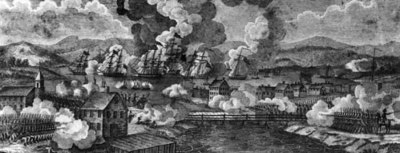
Washington Burned
Bladensburg, 5pm, Wednesday, August 24, 1814
British General Ross decided rest was imperative. Details buried some of the dead and collected stragglers, and Barney’s captured artillery was destroyed. The British suffered greater casualties than the Americans, a measure of their costly charges in the face of artillery fire. Officially, the British reported 64 dead, 138 wounded, and another 107 captured or missing, but the numbers were likely higher. The Americans, by and large, had retreated too quickly to die, suffering at most 40 dead, up to 60 wounded, and 120 captured by WInder’s estimate. The marines accounted for roughly a quarter of the American total, a grim reflection of their brave stand with the flotillamen, who also suffered heavily.
As the British rested, Ross and Cockburn conferred. Despite the exhaustion, there was little sense in giving the American time to regroup. Ross chose the 3rd Brigade, which had seen little combat, to lead the way into Washington; the brigade included the Colonial Marines, the escaped slaves would have the honor of entering the capital as conquerors.
Moving at a fast clip as the daylight waned, the British victors soon reached the outskirts of the capital. No resistance was met. Ross wanted no looting and would enter Washington with only 200 Fusiliers, along with Cockburn and a naval party. A pale moon rose as the troops moved down Maryland Avenue toward the capitol. Ross was not interested in negotiating a deal; instead, he wanted to deliver a message: The public buildings of Washington would burn, but private property would be left alone.
At 8:30pm, Wednesday, August 24, the Washington Navy Yard was set fire by the American commandant, Captain Tingey. By 9pm, British troops with rockets took position in a field on the east side of the Capitol as the burning began. That night a terrible rainstorm, possibly a tornado or hurricane, came through the city dousing the fires. The next morning, the Light Brigade marched into town to rekindle old fires and ignite new ones. The men were accompanied by a contingent of thirty African American Colonial Marines carrying rockets and powder. Soon the Treasury was burning again, and by 8 am on Thursday, August 25, the brick building housing the War, Navy, and State departments went up in flames, fueled by voluminous government records. That evening, the British set an 8pm curfew to keep residents inside their homes. Shortly after sunset, just twenty-four hours after capturing Washington, the British abandoned the American capital. The troops marched in good order to Bladensburg in ninety minutes, halting to load the wounded and distribute provisions. The moon had risen by the time they reached the village, and the pale light revealed the grim sight of corpses strewn about the battlefield. Although the British rear guard, aided by field slaves from the nearby Riversale plantation, had already buried more than a hundred bodies, many more remained, grotesquely transformed by the terrible heat and violent rain.
At midnight, bugles sounded and the British again took up the march. Beyond town, the road worsened, covered with trees blown down in the storm. Exhausted men struggled to keep up and fell off by the dozens. The sun had been up for several hours on August 26 when Ross finally halted around 8am. The men collapsed under trees, on roadsides, or anywhere they could find, and were asleep in an instant.
Excerpted from “Through the Perilous Fight,” by Steve Vogel, published in 2013 by Random House.
-
Bladensburg in 1814
-
Unorganized and Unprepared
-
Surge Across the Bridge
-
Second American Line
-
Marching Across Prince George's County
-
British March & Colonial Marines
-
Famous Footsteps
-
Bunker Hill Road Retreat
-
Joshua Barney at the Third Line
-
American Stand at the Third Line
-
Flanked and Retreat
-
Barney Wounded
-
Washington Burned
-
The Star Spangled Banner Story
-
The Bladensburg Dueling Grounds